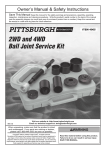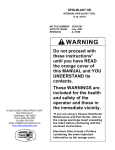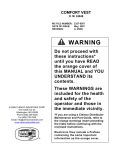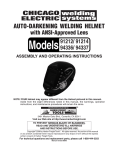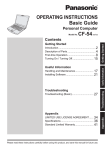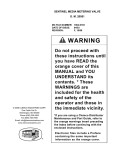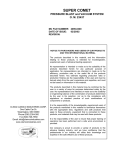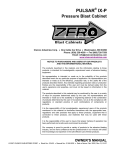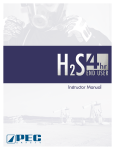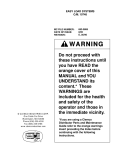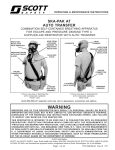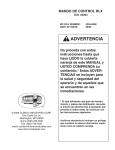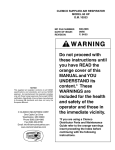Download TLR-50 Pneumatic Remote Controls
Transcript
1/2" REMOTE CONTROLS MODEL TLR-50 O.M. 03358 MC FILE NUMBER: 123-0477 DATE OF ISSUE: 04/01/77 REVISION: H, 03-04 WARNING © CLEMCO INDUSTRIES CORP. One Cable Car Dr. Washington, MO 63090 Phone (636) 239-4300 Fax (636) 239-0788 Email: [email protected] www.clemcoindustries.com ® Do not proceed with these instructions until you have READ the preface of this MANUAL and YOU UNDERSTAND its contents. These WARNINGS are included for the health and safety of the operator and those in the immediate vicinity. Keep this manual for future reference PREFACE GENERAL INSTRUCTIONS WARNING • • • Described herein are some, BUT NOT ALL, of the major requirements for safe and productive use of blast machines, remote control systems, operator respirator assemblies, and related accessories. Completely read ALL instruction manuals prior to using equipment. Read and follow ALL instructions before using this equipment. Failure to comply with ALL instructions can result in serious injury or death. In the event that the user, or any assistants of the user of this equipment cannot read or cannot completely understand the warnings and information contained in these instructions, the employer of the user and his assistants must thoroughly educate and train them on the proper operation and safety procedures of this equipment. The user's work environment may include certain HAZARDS related to the abrasive blasting operation. Proper protection for the blaster, as well as anyone else that may be EXPOSED to the hazards generated by the blasting process, is the responsibility of the user and/or the employer. Operators MUST consult with their employer about what hazards may be present in the work environment including, but not limited to, exposure to dust that may contain TOXIC MATERIALS due to the presence of silica, cyanide, arsenic or other toxins in the abrasive, or materials present in the surface to be blasted such as lead or heavy metals in coatings. The environment may also include fumes that may be present from adjacent coatings application, contaminated water, engine exhaust, chemicals, and asbestos. The work area may include PHYSICAL HAZARDS such as an uneven work surface, poor visibility, excess noise, and electrical hazards. The operator MUST consult with his employer on the identification of potential hazards, and the appropriate measures that MUST be taken to protect the blaster and others that might be exposed to these hazards. NOTICE TO PURCHASERS AND USERS OF OUR PRODUCTS AND THIS INFORMATIONAL MATERIAL The products described in this material, and the information relating to those products, is intended for knowledgeable, experienced users of abrasive blasting equipment. No representation is intended or made as to the suitability of the products described herein for any particular purpose or application. No representations are intended or made as to the efficiency, production rate, or the useful life of the products described herein. Any estimate regarding production rates or production finishes are the responsibility of the user and must be derived solely from the user’s experience and expertise, and must not be based on information in this material. ALL machines, components and accessories MUST be installed, tested, operated and maintained only by trained, knowledgeable, experienced users. The products described in this material may be combined by the user in a variety of ways for purposes determined solely by the user. No representations are intended or made as to the suitability or engineering balance of the combination of products determined by the user in his selection, nor as to the compliance with regulations or standard practice of such combinations of components or products. DO NOT modify or substitute any Clemco parts with other types or brands of equipment. Unauthorized modification and parts substitution on supplied air respirators is a violation of OSHA regulations and voids the NIOSH approval. Abrasive Blast Equipment is only a component of the range of equipment used in an abrasive blasting job. Other products may include an air compressor, abrasive, scaffolding, hydraulic work platforms or booms, paint spray equipment, dehumidification equipment, air filters and receivers, lights, ventilation equipment, parts handling equipment, specialized respirators, or equipment that while offered by Clemco may have been supplied by others. Each manufacturer and supplier of the other products used in the abrasive blasting job must be contacted for information, training, instruction and warnings with regard to the proper and safe use of their equipment in the particular application for which the equipment is being used. The information provided by Clemco is intended to provide instruction only on Clemco products. All operators must be trained in the proper, safe, use of this equipment. It is the responsibility of the users to familiarize themselves with, and comply with, all appropriate laws, regulations, and safe practices that apply to the use of these products. Consult with your employer about training programs and materials that are available. OPERATIONAL INSTRUCTIONS OPERATOR SAFETY EQUIPMENT WARNING • • • Our company is proud to provide a variety of products to the abrasive blasting industry, and we have confidence that the professionals in our industry will utilize their knowledge and expertise in the safe efficient use of these products. Blast operators and others working in the vicinity of abrasive blasting must always wear properlymaintained, NIOSH-approved, respiratory protection appropriate for the job site hazards. DO NOT USE abrasives containing more than one percent crystalline (free) silica. Ref. NIOSH Alert #92-102 Inhalation of toxic dust (crystalline silica, asbestos, lead paint and other toxins) can lead to serious or fatal disease (silicosis, asbestosis, lead or other poisoning). • ALWAYS wear NIOSH-approved supplied-air respirators as required by OSHA, in the presence of any dust including, but not limited to, handling or loading abrasive; blasting or I PREFACE working in the vicinity of blast jobs; and cleanup of expended abrasive. Prior to removing respirator, an air monitoring instrument should be used to determine when surrounding atmosphere is clear of dust and safe to breathe. equipment. If controls are altered, involuntary activation, which may cause serious injury, can occur. • Inspect the air control orifice DAILY for cleanliness. NEVER use welding hose in place of twinline control hose. The internal diameter and rubber composition are UNSAFE for remote control use. • NIOSH-approved, supplied-air respirators are to be worn ONLY in atmospheres: • NOT IMMEDIATELY dangerous to life or health and, • from which a user can escape WITHOUT using the respirator. • UNLESS OTHERWISE SPECIFIED, maximum working pressure of blast machines and related components MUST NOT exceed National Board approved 125 psig (8.5 BAR). • Clemco supplied-air respirators DO NOT REMOVE OR PROTECT AGAINST CARBON MONOXIDE (CO) OR ANY OTHER TOXIC GAS. Carbon monoxide and toxic gas removal and/or monitoring device must be used in conjunction with respirator to insure safe breathing air. • NEVER weld on blast machine. Welding may affect dimensional integrity of steel wall and WILL VOID National Board approval. • Point nozzle ONLY at structure being blasted. High velocity abrasive particles WILL inflict serious injury. Keep unprotected workers OUT of blast area. • Air supplied to respirator MUST BE AT LEAST GRADE D QUALITY as described in Compressed Gas Association Commodity Specification G-7.1, and as specified by OSHA Regulation 1910.139 (d). • NEVER attempt to manually move blast machine when it contains abrasive. EMPTY machines, up to 6 cu. ft.(270kg) capacity, are designed to be moved: • on flat, smooth surfaces by AT LEAST two people; • with the Clemco "Mule"; or • with other specially designed machine moving devices. • ALWAYS locate compressors to prevent contaminated air (such as CO from engine exhaust) from entering the air intake system. A suitable in-line air purifying sorbent bed and filter or CO Monitor should be installed to assure breathing air quality. • ALWAYS use a NIOSH-approved breathing air hose to connect an appropriate air filter to the respirator. Use of a nonapproved air hose can subject the operator to illness caused by the release of chemical agents used in the manufacture of nonapproved breathing air hose. • Larger empty blast machines or ANY blast machine containing abrasive MUST be transported by mechanical lifting equipment. AIR HOSE, BLAST HOSE, COUPLINGS, AND NOZZLE HOLDERS • ALWAYS check to make sure air filter and respirator system hoses are NOT CONNECTED to in-plant lines that contain nitrogen, acetylene or any other non-breathable gas. NEVER use oxygen with air line respirators. NEVER modify air line connections to accommodate air filter/respirator breathing hose WITHOUT FIRST testing content of the air line. FAILURE TO TEST THE AIR LINE MAY RESULT IN DEATH TO THE RESPIRATOR USER. • Air hose, air hose fittings and connectors at compressors and blast machines MUST be FOUR times the size of the nozzle orifice. Air hose lengths MUST be kept as short as possible AND in a straight line. Inspect DAILY and repair leakage IMMEDIATELY. • Blast hose inside diameter MUST be THREE to FOUR times the size of the nozzle orifice. AVOID sharp bends that wear out hose rapidly. Use SHORTEST hose lengths possible to reduce pressure loss. Check blast hose DAILY for soft spots. Repair or replace IMMEDIATELY. • Respirator lenses are designed to protect against rebounding abrasive. They do not protect against flying objects, glare, liquids, radiation or high speed heavy materials. Substitute lenses from sources other than the original respirator manufacturer will void NIOSH-approval of this respirator. • ALWAYS cut loose hose ends square when installing hose couplings and nozzle holders to allow uniform fit of hose to coupling shoulder. NEVER install couplings or nozzle holders that DO NOT provide a TIGHT fit on hose. ALWAYS use manufacturers recommended coupling screws. BLAST MACHINES AND REMOTE CONTROLS • Replace coupling gaskets FREQUENTLY to prevent leakage. Abrasive leakage can result in dangerous coupling failure. ALL gaskets MUST be checked SEVERAL times during a working day for wear, distortion and softness. WARNING • • ALWAYS equip abrasive blast machines with remote controls. Abrasive blast machine operators must wear NIOSHapproved supplied-air respirators (ref: OSHA regulations 1910.94, 1910.132, 1910.139 and 1910.244). • Install safety pins at EVERY coupling connection to prevent accidental disengagement during hose movement. • ALWAYS attach safety cables at ALL air hose AND blast hose coupling connections. Cables relieve tension on hose and control whipping action in the event of a coupling blow-out. • NEVER modify OR substitute remote control parts. Parts from different manufacturers are NOT compatible with Clemco II PREFACE of defective parts or, at seller’s option, refund of the purchase price, as set forth below: 1. Seller makes no warranty with respect to products used other than in accordance hereunder. 2. On products seller manufactures, seller warrants that all products are to be free from defects in workmanship and materials for a period of one year from date of shipment to buyer, but no warranty is made that the products are fit for a particular purpose. 3. On products which seller buys and resells pursuant to this order, seller warrants that the products shall carry the then standard warranties of the manufacturers thereof, a copy of which shall be made available to customer upon request. 4. The use of any sample or model in connection with this order is for illustrative purposes only and is not to be construed as a warranty that the product will conform to the sample or model. 5. Seller makes no warranty that the products are delivered free of the rightful claim of any third party by way of patent infringement or the like. 6. This warranty is conditioned upon seller’s receipt within ten (10) days after a buyer’s discovery of a defect, of a written notice stating in what specific material respects the product failed to meet this warranty. If such notice is timely given, seller will, at its option, either modify the product or part to correct the defect, replace the product or part with complying products or parts, or refund the amount paid for the defective product, any one of which will constitute the sole liability of seller and a full settlement of all claims. No allowance will be made for alterations or repairs made by other than those authorized by seller without the prior written consent of seller. Buyer shall afford seller prompt and reasonable opportunity to inspect the products for which any claim is made as above stated. MAINTENANCE • ALWAYS shut off compressor and depressurize blast machine BEFORE doing ANY maintenance. • Always check and clean ALL filters, screens and alarm systems when doing any maintenance. • ALWAYS cage springs BEFORE disassembling valves IF spring-loaded abrasive control valves are used. • ALWAYS completely follow owner's manual instructions and maintain equipment at RECOMMENDED intervals. ADDITIONAL ASSISTANCE • Training and Educational Programs. Clemco Industries Corp. offers a booklet, Blast-Off 2, developed to educate personnel on abrasive blast equipment function and surface preparation techniques. Readers will learn safe and productive use of machines, components and various accessories, including selection of abrasive materials for specific surface profiles and degrees of cleanliness. • The Society for Protective Coatings (SSPC) offers a video training series on protective coatings including one entitled "Surface Preparation." For loan or purchase information, contact SSPC at the address shown below. TECHNICAL DATA AND RESEARCH COMMITTEES • The following associations offer information, materials and videos relating to abrasive blasting and safe operating practices. The Society for Protective Coatings (SSPC) 40 24th Street, Pittsburgh PA 15222-4643 Phone: (412) 281-2331 • FAX (412) 281-9992 Email: [email protected] • Website: www.sspc.org National Association of Corrosion Engineers (NACE) 1440 South Creek Drive, Houston TX 77084 Phone: (281) 228-6200 • FAX (281) 228-6300 Email: [email protected] • Website: www.nace.org American Society for Testing and Materials (ASTM) 100 Barr Harbor Dr., West Conshohocken, PA 19428 Phone (610) 832-9500 • FAX (610) 832-9555 Email: [email protected] • Website: www.astm.org Except as expressly set forth above, all warranties, express, implied or statutory, including implied warranty of merchantability, are hereby disclaimed. DAILY SET-UP CHECK LIST WARNING • • • • NOTICE • This equipment is not intended to be used in an area that might be considered a hazardous location as described in the National Electric Code NFPA 70 1996, article 500. • WARRANTY The following is in lieu of all warranties express, implied or statutory and in no event shall seller or its agents, successors, nominees or assignees, or either, be liable for special or consequential damage arising out of a breach of warranty. This warranty does not apply to any damage or defect resulting from negligent or improper assembly or use of any item by the buyer or its agent or from alteration or attempted repair by any person other than an authorized agent of seller. All used, repaired, modified or altered items are purchased “as is” and with all faults. In no event shall seller be liable for consequential or incidental damages. The sole and exclusive remedy of buyer for breach of warranty by seller shall be repair or replacement ALL piping, fittings and hoses MUST be checked DAILY for tightness and leakage. ALL equipment and components MUST be thoroughly checked for wear. ALL worn or suspicious parts MUST be replaced. ALL blast operators MUST be properly trained to operate equipment. ALL blast operators MUST be properly outfitted with abrasive resistant clothing, safety shoes, leather gloves and ear protection. BEFORE blasting ALWAYS use the following check list. □ 1. PROPERLY MAINTAINED AIR COMPRESSOR sized to provide sufficient volume (cfm) for nozzle and other tools PLUS a 50% reserve to allow for nozzle wear. Use large compressor outlet and large air hose (4 times the nozzle orifice size). FOLLOW MANUFACTURERS MAINTENANCE INSTRUCTIONS. □ 2. BREATHING AIR COMPRESSOR (oil-less air pump) capable of providing Grade D Quality air located in a dust free, contaminant free area. If oil-lubricated air compressor is used to supply respirator, it should have high temperature monitor III PREFACE and CO monitor or both. If CO monitor is not used, air MUST be tested FREQUENTLY to ensure proper air quality. □ 8. BLAST HOSE with ID 3 to 4 times the nozzle orifice. Lines MUST be run AS STRAIGHT AS POSSIBLE from machine to work area with NO sharp bends. Check DAILY for internal wear and external damage. □ 3. Clean, properly maintained NIOSH-APPROVED SUPPLIED-AIR RESPIRATOR. ALL components should ALWAYS be present. NEVER operate without inner lens in place. Thoroughly inspect ALL components DAILY for cleanliness and wear. ANY substitution of parts voids NIOSH approval i.e. cape, lenses, breathing hose, breathing air supply hose, air control valve, cool air or climate control devices. □ 4. OSHA required BREATHING AIR FILTER for removal of moisture and particulate matter from breathing air supply. THIS DEVICE DOES NOT REMOVE OR DETECT CARBON MONOXIDE (CO). ALWAYS USE CO MONITOR ALARM. 9. HOSE COUPLINGS, NOZZLE HOLDERS fitted SNUGLY to hose end and installed using PROPER coupling screws. Coupling lugs MUST be snapped FIRMLY into locking position. Gasket MUST form positive seal with safety pins inserted through pin holes. Check gaskets and replace if ANY sign of wear, softness or distortion. ALWAYS install safety cables at every connection to prevent disengagement. Check nozzle holder for worn threads. NEVER MIX DIFFERENT BRANDS OF COMPONENTS. Check each of these components DAILY. □ □ □ 10. Inspect NOZZLE and GASKET DAILY for wear. Replace nozzle when 1/16" larger than original size or if liner appears cracked. Check nozzle threads for wear. 5. ASME CODED BLAST MACHINE sized to hold 1/2 hour abrasive supply. ALWAYS ground machine to eliminate static electricity hazard. Examine pop up valve for alignment. Blast machine MUST be fitted with a screen to keep out foreign objects and a cover to prevent entry of moisture overnight. □ 11. Use abrasive that is properly sized and free of harmful substances; such as, free silica, cyanide, arsenic or lead. Check material data sheet for presence of toxic or harmful substances. □ 6. AIR LINE FILTER installed AS CLOSE AS POSSIBLE to machine inlet. Sized to match inlet piping or larger air supply line. Clean filter DAILY. Drain OFTEN. □ 12. Test surface to be blasted for toxic substances. Take appropriate, and NIOSH required, protective measures for operator and bystanders which pertain to substances found on the surface to be blasted. □ 7. REMOTE CONTROLS MUST be in PERFECT operating condition. ONLY use APPROVED spare parts, including twin- line hose. DAILY: test system operation and check button bumper and spring action of lever and lever lock. DO NOT USE WELDING HOSE. 1 Air Compressor 11. Silica-free Abrasive 2. Breathing Air Compressor (or) 2. Ambient Air Pump for low pressure respirator 5. ASME Coded Blast Machine 7. Remote Controls 3. NIOSH Approved Supplied-Air Respirator 6. Air Line Filter 10. Appropriately Sized Nozzle 4. CPF Air-Filter 8. Blast Hose 9. Hose Couplings and Safety Cables IV TLR-50 PNEUMATIC REMOTE CONTROLS 1.0 INTRODUCTION 1.1 Scope 1.1.1 This manual covers installation, operation, maintenance, troubleshooting, and replacement parts for Clemco TLR-50, 1/2" NPT Remote Control System. 1.1.2 All blast operator(s) and machine (pot) tenders must be trained in the safe operation of the remote control system and all other equipment used. They must know about the hazards associated with abrasive blasting. To ensure safe blasting, before using the machine, read the manuals for the specific blast machine and all accessories to be used. Blast Machine, Manual No. ................................... 04124 RLX Control Handle, Manual No. .......................... 10574 1.2 Safety Alerts 1.2.1 Clemco uses safety alert signal words, based on ANSI Z535.4-1998, to alert the user of a potentially hazardous situation that may be encountered while operating this equipment. ANSI’s definitions of the signal words are as follows: This is the safety alert symbol. It is used to alert the user of this equipment of potential personal injury hazards. Obey all safety messages that follow this symbol to avoid possible injury or death. CAUTION Caution used without the safety alert symbol indicates a potentially hazardous situation which, if not avoided, may result in property damage. CAUTION Caution indicates a potentially hazardous situation which, if not avoided, may result in minor or moderate injury. WARNING Warning indicates a potentially hazardous situation which, if not avoided, could result in death or serious injury. Page 1 DANGER Danger indicates an imminently hazardous situation which, if not avoided, will result in death or serious injury. 1.3 General Description 1.3.1 Clemco installs TLR-50 remote controls on 0.5 and 1.0 cu ft. blast machines. OSHA requires remote controls on all blast machines when an operator controls the nozzle. 1.3.2 The control handle, located near the blast nozzle, is the activator for the remote control valves. When the operator intentionally or unintentionally removes handheld pressure from the remote control handle, the machine deactivates, stopping air and abrasive flow through the nozzle. The remote control system “fails to safe”, which means any interruption in the control-air circuit for reasons such as a break in the line, the compressor stops running, or the operator drops the blast hose, the remote controls deactivate the blast machine. WARNING Never modify or substitute remote control parts. Parts from different manufacturers are not compatible with Clemco equipment. If ANY part of the remote control system is altered, involuntary activation, which may cause serious injury, can occur. 1.3.3 The components are shown in Figure 1. They include the inlet valve, diaphragm outlet valve, RLX control handle, 25-ft. and 3-ft. long twinline control hoses, 2 control hose unions, and an 18-in. long interconnecting hose. 1.3.4 TLR-50 Remote Controls are pressure-release style systems which control the pressurization and depressurization of the blast machine. Pressurization occurs when the control handle is pressed and depressurization occurs when the handle is released. 1.4 Operating Principles 1.4.1 Clemco Recova Remote Controls operate pneumatically on return air (See Figure 1). If the control handle lever (the main activator of the system) is in the up (no blast) position, one stream of air travels down the outbound side of the twinline and escapes through an opening located under the lever. The normally-closed inlet valve remains closed, and the normally-open outlet TLR-50 PNEUMATIC REMOTE CONTROLS Page 2 18-Inch Hose Diaphragm Outlet Valve Safety Petcock Inlet Valve 3-Foot Twinline Hose Orifice Fitting Twinline Hose Unions (2) 25-Foot Twinline Hose RLX Control Handle Figure 1 valve remains open. When the control handle lever is pressed, the opening is sealed, and air in the outbound line returns through the inbound line to open the inlet valve and close the outlet valve. This action pressurizes the blast machine and begins the blasting process. Releasing the handle exhausts the control air, which closes the inlet valve, and opens the outlet valve to depressurize the blast machine and stop the blasting. 2.0 INSTALLATION 2.2.1 Remove the existing inlet valve and replace it with the Recova Inlet Valve. The directional arrow on the valve points toward the blast machine, indicating the direction of air flow. 2.2.2 2.2.3 Install the diaphragm outlet valves so the 1” NPT exhaust port faces a safe direction. NOTE: The exhaust port usually faces down. However, an optional Clemco exhaust muffler (See Section 7.1) may be installed in the exhaust port with the port facing up, or exhaust piping installed, and vented into a safe area. 2.1 Factory installation: If the remote control has been factory installed, skip to Paragraph 2.3. 2.2 Field Installation: Refer to Figure 1. WARNING Failure to observe the following procedure could cause serious injury or death from the sudden release of compressed air. • Empty the blast machine of abrasive. • Depressurize the blast machine. • Lock out and tag out the compressed air supply. • Bleed the air supply line to the blast machine. Remove the existing outlet valve. WARNING If a muffler is not used, the exhaust piping must be plumbed to direct exhausting air in a direction that ensures no persons will be exposed to possible injury from high velocity air and media which escape when the blast machine is depressurized. 2.3 Blast hose and control hose connections 2.3.1 Uncoil the blast hose and lay the 25-ft. twinline hose alongside it. TLR-50 PNEUMATIC REMOTE CONTROLS 2.3.2 Band the control handle to the blast hose close to the nozzle holder, using the two nylon ties provided. Once the control is firmly attached, clip the tie ends so they will not snag the operator's clothing or interfere with the operation of the control handle. 2.4.3 Attach the 25-ft. twinline hose to the two fittings on the control handle. Either side of the hose can be attached to either fitting. 2.3.4 Working from the control handle back, band or tape the twinline hose to the blast hose every four to six feet, and as close to the couplings as possible. 2.3.5 Make sure the coupling gaskets are in place and not worn before connecting the blast hose to the quick coupling on the blast machine. To reduce the risk of accidental coupling separation when the hose is under pressure, use safety lock-pins or safety wire to lock the couplings together. WARNING Hose disconnection while under pressure could cause serious injury or death. Use safety lockpins and safety cables on all coupling connections to help prevent hose couplings from accidental disconnection. 3.0 Page 3 OPERATION WARNING Refer to the manuals listed in paragraph 1.1.2. Do not operate this equipment before reading the instruction manuals for all equipment. 3.1 Start-Up 3.1.1 Make sure that all hose connections are secured with safety lock-pins and safety cables to prevent accidental separation or disconnection. 3.1.2 Connect the blast machine to an adequate air supply. The compressor should be located upwind from the blasting operation to prevent dust from entering the compressor intake. 3.1.3 Make sure that the safety petcock located on the inlet valve is open. The petcock is open when the petcock lever is in-line with the petcock, as shown if Figure 2. Open 2.3.6 Screw the two hose unions into the unattached fittings of the 25-ft. twinline hose. 2.3.7 Attach the 3-ft. twinline control hose to the inlet valve as shown in Figure 1. One side of the hose connects to the unused upper elbow, the other to the orifice fitting. Closed 2.3.8 Connect the other end of the 3-ft. twinline to the hose unions on the 25-ft. twinline. Either side can connect to either union. 2.3.9 Band the control hoses on the blast machine side of the unions to the quick coupling nipple. 2.3.10 Make sure that all fittings are tight. Leaks will cause the system to malfunction. Figure 2 WARNING To prevent severe injury from accidental activation of the blast machine, open the safety petcock when the blast machine is not in use. Opening the petcock prevents unintentional blasting. The control handle can not activate the machine when the petcock is open. TLR-50 PNEUMATIC REMOTE CONTROLS 3.1.4 Check to make sure that the remote control handle lever is in the up (no blast) position, and that the handle lever and safety lock move freely. WARNING A separate manual is supplied with the remote control handle. Do not operate the machine before first reading the remote control handle operating instructions. 3.1.5 Check to make sure that the handle lever will not seal the opening on control handle, unless the safety lever lock is pulled down. WARNING Malfunctioning control handles could cause unintentional actuation of a blast machine, or prevent a machine from deactivating upon release. Malfunctioning control handles must be taken out of service immediately and repaired or replaced. Serious injury or death can result from unintentional blasting. WARNING All persons except for the machine tender must stay clear of the blast machine. The blast operator could pressurize or depressurize the machine at any time. The noise generated by the sudden release of compressed air when the machine is pressurized or depressurized, may startle bystanders, and could vent abrasive under pressure. Either condition could result in injury. The machine tender must wear a suitable respirator, plus satisfactory eye, face, and hearing protection. 3.1.10 When the blast operator is ready, either the operator or the machine tender stands away from the concave filling head of the blast machine, and the exhaust port and then closes the safety petcock. Closing the petcock prepares the machine for remote operation, and activation by the control handle. Air should be heard escaping from the orifice under the control handle lever but nowhere else. The noise from air escaping at the control handle is an audible signal, warning that air is supplied to the blast machine, and will activate if the control handle is pressed. 3.2 3.1.6 Start the compressor, and bring it up to operating temperature and pressure. Blasting pressure is usually high than 50 pounds per square inch (psi) but must not exceed the blast machine’s pressure rating. 3.1.7 Fill the machine with screened, clean, dry abrasive that is manufactured specifically for abrasive blasting. 3.1.8 Open the compressor air supply valve to pressurize the air supply line. Listen for noise that indicates any open lines or leaks. 3.1.9 Do not allow anyone within 10 feet of the blast machine except machine tenders who are appropriately fitted with proper protective equipment, because the blast operator could pressurize and depressurize the machine without warning. Page 4 Blasting WARNING Failure to wear approved respirators could result in serious lung disease or death. Abrasive blasting produces harmful dust. Do not blast without the use of a properly fitted and maintained NIOSH-approved, type CE SuppliedAir Respirator that is approved for abrasive blasting. Everyone in the blasting area must wear an approved respirator. Abrasive blasting could cause abrasive particles around the blast machine and blast nozzle to become airborne. The loud sounds of air released at the blast machine and nozzle could cause hearing damage. Anyone in the blasting area must wear approved eye protection and hearing protection. 3.2.1 Operators must wear appropriate protective gear, including: abrasive-resistant clothing, leather gloves, eye and hearing protection, and a NIOSHapproved Type CE Supplied-Air Respirator. TLR-50 PNEUMATIC REMOTE CONTROLS 3.3 Start Blasting 3.3.1 Hold the blast hose securely and point the nozzle only at objects intended to be blast cleaned. 3.3.2 Pull back the safety lever lock and depress the remote control handle. Within a few seconds the pop-up valve will automatically pop up and the blast machine will pressurize to start blasting. WARNING OSHA requires the use of remote controls on all blast machines. To comply with OSHA regulations, the remote control handle which starts and stops the flow of air and abrasive, must be held down manually. Do not tie down the control handle lever or attempt to bypass any part of the remote control system. Doing so will defeat the purpose of the fail-to-safe feature of the remote control. Serious injury or death can result from uncontrolled blasting. Ref. 29 CFR 1910.244(b). 3.4 Stop Blasting 3.4.1 To stop blasting, release the control handle. The outlet valve will open and the blast machine will depressurize. The pop-up valve automatically drops when air is expelled from the machine and pressure equalizes. 3.4.2 When the control handle lever is released, the safety lever lock will flip up to lock the handle lever in the up (open) position. 3.4.3 Make sure that the control handle safety lever lock is up, and that it prevents the handle lever from engaging. 3.4.4 Always open the safety petcock during work breaks and before filling the blast machine. Opening the petcock prevents unintentional blasting. Page 5 WARNING When approaching an idle blast machine, and before loading the blast machine with abrasive, always check to make sure the safety petcock is open. This step is especially important if one worker (a machine tender) loads the machine with abrasive while another worker (the blast operator) controls the blasting. The blast operator could pressurize the machine before the machine tender has moved away from the machine. During pressurization abrasive could be forced out of the top of the machine, and cause injury. 4.0 PREVENTIVE MAINTENANCE NOTE: These preventive maintenance instructions pertain to the remote controls only. Read the owners manuals for the blast machine and all blast accessories, for inspection and maintenance schedules of that equipment. 4.1 Daily 4.1.1 With the air off, before beginning blasting, inspect the following: • Inspect the RLX Control Handle; look for the following: • The lever must not seal the opening on the control unless the safety lever lock is pulled down. • The handle lever must return to the "up" position when released. • The safety lever lock must return to the "up" position when the handle lever is released. • Both the handle lever and safety lever lock must move freely with no drag or binding. WARNING Malfunctioning control handles could cause unintentional actuation of a blast machine, or prevent a machine from deactivating upon release. Malfunctioning control handles must be taken out of service immediately and repaired or replaced. Serious injury or death could result from unintentional blasting. TLR-50 PNEUMATIC REMOTE CONTROLS 4.1.2 • While blasting, inspect the following: Check the control handle for leaks. 4.2 Weekly 4.2.1 Inspect the following while blasting. • 4.3 Inspect all control hoses, and valves for leaks. If leaks are found, stop blasting and repair. Periodic Inspection NOTE: Periodic inspection of the following items will help avoid unscheduled down-time. 5.1 Page 6 Inlet Valve, Ref. Figure 5 5.1.1 All service on the inlet valve must be done with the air off and the air supply locked-out and tagged-out. 5.1.2 Use snap-ring pliers to remove the top and bottom retaining rings. 5.1.3 To remove the top cap, twist the petcock/cross assembly while pulling up. 5.1.4 Pull down on the bottom plug to remove it. If necessary, use pliers to grab the wrench flats to remove it from the body. Cup the bottom opening to catch the spring, retainer, and washer as the plug is removed. 4.3.1 The remote control system is a safety device. To be safe and to avoid unscheduled down-time, the internal parts of the inlet valve and outlet valve should be inspected periodically. Inspect them for wear and lubrication of O-rings, pistons, springs, seals, and castings. See Service Maintenance in Section 5. 5.1.5 If the piston cannot be removed with finger or thumb force, use a dowel or similar object inserted through the bottom opening to push the piston assembly out the top. 4.3.2 The control handle is the actuator of the remote control system. Periodically clean around the springs, handle lever, and safety lever lock to ensure that the unit is free of abrasive and debris that could cause the handle lever or safety lever lock to bind. See the RLX Owners Manual for service instructions. • 4.4 • Lubrication 4.4.1 Once per week, while the air is off, put one or two drops of lightweight machine oil in the inlet valve through the safety petcock. This lubricates the piston and O-rings in the inlet and outlet valves. 5.1.6 • • Clean all parts and inspect for wear as follows: The spring is approximately 1" long. If it is rusted or compressed, replace it. Inspect the piston, rubber washer, washer retainer top cap and bottom plug for damage. Replace all damaged parts. Look into the bottom opening in the valve body. If the machined seat is worn, replace the body. Inspect all O-rings. If any are damaged or flattened, replace them. 5.1.7 Remove the lower twinline hose connection, and remove the orifice fitting for inspection. Clean the 1/16″ orifice and reassemble the connection. WARNING 5.0 SERVICE MAINTENANCE WARNING Failure to observe the following before performing any maintenance could cause serious injury or death from the sudden release of compressed air. • Depressurize the blast machine. • Lock out and tag out the compressed air supply. • Bleed the air supply line to the blast machine. The orifice fitting must not be removed, modified, or substituted with another fitting. Altering the orifice fitting may cause involuntary activation of the blast machine or some other malfunction which could result in serious injury. 5.1.8 Lubricate all O-rings, and use the illustration in Figure 5, to reassemble the valve in reverse order, assembling the top end first. 5.2 Diaphragm Outlet Valve, Ref. Figure 4 5.2.1 All service on the outlet valve must be done with the air off and the air supply locked-out and tagged-out. TLR-50 PNEUMATIC REMOTE CONTROLS 5.2.2 Remove the cap by unscrewing the four cap screws. 5.2.3 Remove the diaphragm and inspect it for damage. Replace as necessary. 5.2.4 Inspect the machined seat in the body. If worn, replace the body. 5.2.5 Reassemble in reverse order. 5.3 Control handle 5.3.1 A separate manual is provided for the control handle. Refer to the manual to service the control handle. 6.0 TROUBLESHOOTING NOTE: This section applies to the remote control system only. See the appropriate manual for troubleshooting the blast machine, control handle, and accessories. WARNING To avoid serious injury or death, observe the following when troubleshooting the remote controls: • Turn off the air, and lock out and tag out the air supply. • When checking the controls requires air, always enlist the aid of another person to operate the control handle while holding the nozzle securely and pointing it in a safe direction. • Never strap down the remote control handle lever in the operating position. Page 7 6.1.3 Check for air leaks in control hose, fittings, and control handle. (RLX Control Handle is covered in Owners Manual No. 10574) 6.1.4 Check for air escaping from the opening under the control handle. If no air is escaping, the orifice on the inlet valve (Figure 5, item 9) or the line from the orifice to the control handle is blocked and must be cleared. 6.1.5 Open the safety petcock and depress the control handle. Air should come from the petcock. If it doesn't, check the following: • The opening on the control handle is not being sealed off. • The control handle leaks air. • The line from the control handle to the upper fitting on the inlet valve is blocked. • If a diaphragm outlet valve is used, check the diaphragm for a rupture. If air does rush out, the inlet valve is not functioning. Turn off the air supply and service it per Section 5.1, disassemble the valve, clean and lubricate it, and replace all worn or damaged parts. 6.1.6 Close the safety petcock, and press the control handle lever. Check that no air escapes through the vent hole on the cylinder body of the inlet valve body. Air escaping from this vent indicates a worn piston or O-ring in the inlet valve. See Section 5.1. 6.1.7 With the compressor off and the blast machine depressurized, check the nozzle for blockage. 6.2 Outlet valve won't exhaust or exhausts too slowly. 6.2.1 Make sure that the lower fitting on inlet valve (Figure 5, item 9) has not been replaced with a fitting with a full flow orifice. The orifice on the 1/8" NPT end of the fitting must be 1/16" diameter. 6.2.3 Make sure the inlet valve closes. If it does not seal-off incoming air, the valve requires service. 6.1 No blast action when the control handle is depressed 6.3 Pop-up valve seats for a short time and then falls, or it "hovers" but fails to seat. 6.1.1 Make sure that the air supply is on and all supply valves are open. 6.3.1 Insufficient air supply. Check the compressor output, air supply hose and isolation valves. 6.1.2 6.3.2 Outlet valve diaphragm may be worn or ruptured. Inspect it and replace worn parts. Make sure the safety petcock is closed. TLR-50 PNEUMATIC REMOTE CONTROLS 7.0 REPLACEMENT PARTS 7.4 7.1 Optional Accessories Item Description Exhaust Muffler ......................................... 05068 (-) 1. 2. 3. 4. 5. 6. 7. 8. (-) 7.2 RLX Pneumatic Control Handle Refer to RLX Control Handle Manual No. 10574 for RLX replacement parts. 7.3 1/2" Diaphragm Outlet Valve Figure 4 Stock No. 1/2" NPT Diaphragm outlet valve ................. 02512 Nipple, 1/2" NPT x close .............................. 01733 Diaphragm ................................................... 02511 Washer, 1/4" lock.......................................... 03117 Elbow, 1/4" NPT adaptor ............................. 02513 Cap ............................................................... 02299 Body ............................................................. 02298 Nipple, 1" NPT x 3" TOE .............................. 01841 Screw, 1/4-NC x 1" cap ................................ 03053 System Replacement Parts, Figure 3 Item Description (-) 1. 2. 3. 4. 5. 6. 7. 8. Page 8 Stock No. TLR-50 remote control system .................... 02518 Outlet valve, diaphragm, 1/2" NPT .............. 02512 Inlet valve assembly, 1/2" NPT .................... 02164 RLX control handle ...................................... 10565 Hose, 25' Twinline coupled .......................... 02128 Union, Twinline hose ................................... 01944 Hose, 3' Twinline coupled ............................ 02240 Hose, 3/16" x 18" coupled ........................... 02454 Hose end, reusable ...................................... 01943 6 1 2 5 3 8 4 7 7 1 Figure 4 2 6 5 3 8 4 Figure 3 TLR-50 PNEUMATIC REMOTE CONTROLS 7.5 Inlet Valve, Figure 5 Item Description (-) * 1. 2. 3. 4. 5. 6. 7. 8. 9 Page 9 07814 SERVICE KIT TLR-50 INLET VALVE Stock No. 1/2" Inlet Valve, complete ............................ 02164 Service kit, 1/2" Inlet Valve (Fig. 5a)............. 07814 Cap .............................................................. 02175 Piston ........................................................... 02192 Body ............................................................. 02170 Plug, bottom ................................................. 02176 Elbow, 1/4" NPT adaptor ............................. 02513 Reducer, 1/4" NPT x 1/8" NPT .................... 02026 Cross, 1/4" NPT brass ................................. 02193 Petcock 1/4" NPT ......................................... 01993 Adaptor 1/8" NPT with 1/16" orifice ............. 01945 Item 1. 2. 3. 4. 5. 6. 7. 8. 9. Qty. Description 1 1 1 1 1 1 1 1 1 Retaining ring, cap Retainer, washer Spring, 17/32" OD x 1" long Retaining ring, bottom plug O-ring, 7/8" ID x 1/8" C/S Washer O-ring, 3/4" ID x 3/32" C/S O-ring, 1-1/8" ID x 1/8" C/S O-ring, 1-3/16" ID x 1/8" C/S 8 5 7 6 5 1 * 1 9 * * 8 * 7 2 3 9 * 6 2 * * 3 5 * 4 * 4 Figure 5 Figure 5a















